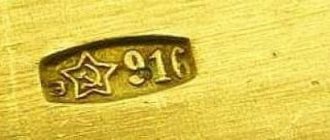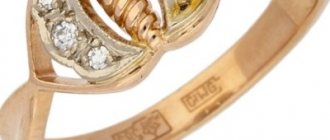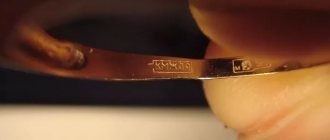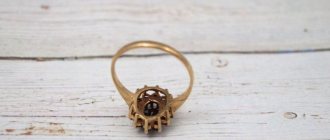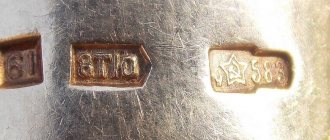Gold hallmark
Gold of different samples
There are a large number of different hallmarks of gold in the world. Each country has its own standards for assaying gold and other precious metals. Gold of different grades differs in color, hardness and price.
Why do you need a gold test?
The digital designation of gold purity is an important component of the structure of the mark. The sample shows how much pure gold is contained in the product. The hallmark of gold is of great importance, as it is a very expensive precious metal. The price of one sample of gold may differ from another sample by 2-3 times. For example, the cost of 999 purity gold is 3 times higher than the price of low-grade 333 purity gold. The price of 375 standard gold is 2 times lower than the cost of 750 standard gold.
What are the hallmarks of gold with letters?
The old masters did not issue certificates to their masterpieces. To distinguish jewelry items, a convex marking was made with a company monogram or designation of who and where the jewelry was made. Some jewelers add additional hallmarks to the gold to make their products stand out from the crowd. This sign is called a “name sign”. It is placed next to the brand and consists of 4 letters. The first letter indicates the year of manufacture. The second letter will indicate the place where the products were tested in accordance with the catalogue. The last 2 letters contain the name of the manufacturer.
High-grade and low-grade gold
Highest quality gold
Gold can be high-grade and low-grade. High-grade gold is most often used in bank bars and coins (antique, collectible, investment). Despite the fact that such gold is the most expensive, jewelry made from it is rare. Fine gold is too soft for widespread use. High-grade gold is used as an investment to preserve savings from depreciation. The highest standard of gold corresponds to the digital designations: 999, 24 carats, 96 spools.
Lowest grade of gold
Low-grade gold has high strength and a significantly lower price. Products with high wear resistance are most often made from it, and much less often - jewelry. Despite its strength and durability, jewelry made from low-grade precious metal does not look as attractive as jewelry made from gold of popular standards. The lowest standard of gold corresponds to digital designations: 333 or 8 carats.
Pros and cons of red gold
Only high-grade alloys have the advantages of sufficient strength; in other cases, excessive fragility and softness are observed. The surface of products made from this metal is characterized by low resistance to damage - the slightest scratches will soon become visible.
Products made from red gold often break, despite the fact that repairing jewelry is expensive. At the same time, there is absolute resistance to metal corrosion.
It is not recommended to try to rub out scratches on the product, as the entire top layer will almost certainly be erased.
Previously made items made of red gold have historical value, and banknotes have numismatic value. Therefore, they can be sold at a high price or bought at a profit as a long-term investment - the older the item, the higher its value.
Popular and rare gold samples
The best samples of gold
Among the gold products, there are both old and rare, as well as well-known gold samples. The most common and popular in many countries are the hallmarks: 585 and 750. This is the so-called gold standard among jewelry. Today, jewelers around the world most often use standard gold hallmarks: 375 (9 karats), 585 (14 karats), 750 (18 karats), 999 (24 karats).
Old gold samples
In many countries, gold products are often found, the surface of which is marked with old hallmarks. Such old gold has the hallmarks of outdated karat, spool and even metric hallmarks (583 hallmark). Some antique gold items contain the rarest hallmarks of gold.
Which sample is better
What is it - the best sample of gold? This question cannot be answered unequivocally - the answer depends on the purposes for which you purchase the precious metal. Do you want to save your savings? The best one for you will be a gold bank bar. Need reliable wedding rings? 585 standard is the key to long wear of jewelry. Do you dream of having a truly unique and expensive piece of jewelry? 750 sample will be the best gift for you.
The answer to the question which sample is better depends on the country of residence:
- In Russia, the best “engagement” is considered to be 585.
- The traditional standard of gold in wedding jewelry in Europe and the USA is 750. However, here symbols of marriage are usually worn on the left hand, and since most people are right-handed, the wedding ring is subject to less wear.
- For an Indian, both of these alloys are not good enough: 958 jewelry is noteworthy here. Yes, they are easily deformed, but this does not stop the people of India.
- China also has an approximate approach to gold, only they love jewelry marked 999.
The high Au content is the reason why Indian and Chinese gold jewelry is so unusually yellow - their color is as close as possible to the color of a bank gold bar, and so large - the enlargement of the elements gives the jewelry strength. It is important to know about gold, what grades there are, what the composition of these alloys is, in order to be able to compare prices in different jewelry chains and countries of the world, to understand whether the jewelry can be used every day or is it better to leave it for special occasions.
Unfortunately, “Diva” jewelry stores do not carry the 958 standard, beloved by Indians. But here you will find yellow 750 gold preferred by Europeans, 585-carat jewelry in red “Russian” color, and cold steel “high-tech” white alloy. Our specialty is the use of natural precious stones. Check them out in red, white and yellow gold!
Gold assay systems
What are the different gold assay systems?
Today, there are two systems used in the world for measuring gold samples - metric and carat. Also, on the precious metals market you can still find old “royal gold”, which has different hallmarks - royal hallmarks of gold. In Tsarist Russia, there was a system for measuring the fineness of gold in spools for many decades. The spool sampling system operated in Russia for more than two centuries.
Gold hallmarks in carats
In world practice, mainly in Europe, jewelers continue to use the karat gold hallmark system. Jewelry “imported gold” is measured in carats (from 8 to 24 carats). The karat system is based on calculating the proportion of pure gold in 24 weight units of the alloy.
The content of pure gold in the alloy of six popular samples: 8 carats - 33.3%; 9 carats – 37.5%; 12 carats – 50%; 14 carats – 58.5%; 18 carats – 75%; 24 carat – 100%.
Metric gold standards
The most common stamp on gold in the USSR was the mark of metric gold hallmark - 583. It was replaced in Russia, Ukraine and other countries of the former Soviet Union by 585 hallmark, which is more consistent with international hallmarking standards. Metric hallmarks, like carat hallmarks, show the percentage of pure gold in a gold item.
Standard metric gold hallmarks: 333, 375, 500, 585, 750, 999.
Spool gold samples
In Tsarist Russia, a spool sampling system existed for about 200 years. The spool (Russian) sampling system is based on the old measure of weight - a pound, equal to 96 spools. A stamp with the number 56 on a piece of jewelry means that it contains 56 parts of pure gold, the remaining 40 parts are other metals, such as silver and copper.
Russian gold standard: what are they, stamp
What standard is gold in Russia? Our country uses the metric system. In addition to the well-known 585 and 750, there are several more standards established by the state. They can be used not only in the jewelry industry, but also in arts and crafts, dentistry, and manufacturing.
What types of gold are there in Russia:
- 585 is the most popular standard of gold in jewelry in Russia. Perfectly holds the shape of even the most sophisticated jewelry. Practical and inexpensive. Perfect for jewelry that is worn every day.
- 750 – prestigious. Due to the higher precious metal content, it is more expensive, less practical, more ductile, and therefore, as a rule, is used for premium jewelry.
- 999 is a banking brick, investment gold that can be cut with a knife. Jewelry made from such metal quickly wears out, although the wedding rings of many members of the imperial family in Russia were made of pure 999 gold.
- 958 - in Russia it is usually used for making gold leaf, i.e. the thinnest plates of precious metal that become a decorative coating.
- 500 - used for gilding, making cufflinks, brooches, pens, in addition, many foreign-made jewelry that are declared as 14-carat (585), but do not reach the required Au content, receive this mark.
- 375 is a dull, unattractive metal, used for making watches, cigarette cases, church utensils and other household items.
It is not easy to produce an alloy with the exact percentage of Au, which is why there is a remedium for each sample. This term means the maximum permissible deviation from the standard.
White gold ring with diamonds and sapphires 911293SB
This model is made to order
Which gold is better - Soviet or Russian?
Previously, the trees were taller, the skies were clearer, and the gold was better. This is exactly what many of our compatriots think. Is it so? In the USSR, the 583 standard was used, in 2000 it was replaced by the modern 585. Which gold is better, 583 or 585? It would seem that the difference is small - only 0.2%. But…
Remedium in the USSR was defined as 3 units, the percentage of noble metal required for stamping ranged from 58 to 58.6. Russian 585 standard can only have a positive remedium of 5 units, that is, the percentage of precious metal in it is from 58.5 to 59%. The difference in actual gold content can reach 1%. In addition, 585 metal is recognized by jewelers all over the world; it meets international quality standards.
In the USSR, the state established what types of gold there were and their prices. In the Russian Federation, the state establishes only a list of samples, but the price of gold is market price and is generally oriented towards the exchange rate of the precious metal. It may differ from one manufacturer to another. The final price of jewelry is influenced not only by the percentage of gold content in the metal, but also by manufacturing technology, the presence of inserts, serial number, and brand.
What standard is gold for coins?
You can often come across the opinion that gold coins are cast from pure gold. The material for coins is called red gold, i.e. the one from which gold chervonets were made. Even on Wikipedia for a long time one could read the statement that red gold is “the purest gold.” Indeed, the metal for coins had a higher content of noble metal, and yet its percentage was only 90%. So he is far from banking.
White gold ring with diamonds 921439B
This model is made to order
Where to find an hallmark on gold jewelry
The numbers on the stamp near the “girl in a kokoshnik” icon are the required designation of the pure gold content. Next to this mark there is another one - this is the name tag, which contains information about the plant in encrypted form. In order not to spoil the appearance of the jewelry, the mark is placed in the most inconspicuous place:
- on the ring - inside the rim;
- on the pendant - from the wrong side;
- on earrings - on a shvenze, on studs - on a pin;
- on chains and bracelets - on a link near the lock.
From 2021, it is planned to introduce another tag - a QR code nanotag, with the help of which the state will be able to monitor the circulation of precious metals even more closely. True, these marks will be invisible to the buyer.
What kind of sample is this
On jewelry made before 1927, 56 was the most common. Usually, thanks to the mark on these jewelry, you can find out who made the product. Jewels with raised markings are of particular importance, since only after 1897 marks began to be made depressed, similar to modern ones. Compared to today's standards, 56 corresponds to 585 gold.
Briefly about the history of appearance
Mandatory marking on products made of precious metals was introduced by Peter I. The spool system was adopted to systematize the quality of gold, control accounting and at the same time bring order to the jewelry industry. Until 1733, products were made without sample. The proposed classification was used until 1927.
Where did the first mark on gold appear?
Gold marking began in ancient times. The first mark was placed in Lydia, an ancient state. This action made it possible to protect people from fraudulent activities.
In Russia, signs on gold items began to be placed much later than in other countries. The first Moscow stamp is a double-headed eagle, next to which there was a date. It dates back to the period 1651–1652 and was placed on silver items, since silver began to be hallmarked earlier than gold.
At the legislative level, hallmarking of yellow metal in Russia began in 1700. Private jewelers, workshops and factories for the production of precious metal products were required to put a name mark.
Composition and properties
To make this sample, 56 parts of pure gold and 40 parts of alloys were used. In terms of properties, quality and composition, it corresponds 100% to modern 585 standard. The following metals were often used as alloys:
Such alloys changed the color of the alloy, its ductility and wear resistance. Palladium increased the price of the product several times due to its cost.
Strength
Products made from 56 standard have fairly high strength. The strongest jewelry is considered to be made from an alloy containing nickel, brass or zinc. In addition, this ligature made it possible to create various woven patterns on the decoration.
Alloy shade chart
| Photo: 56 sample (tsarist gold), 583 sample (Soviet gold), 585 sample (stamp with a star), new 585 sample |
| Color | Share of gold | Silver | Copper | Nickel |
| Pink (red) | 58.5% | 9% | 32.55% | — |
| Yellow | 58.5% | 18.75% | 22.75% | — |
| Pale yellow | 58.5% | 28% | 13.5 | -? |
| Yellow-green pale | 58.5% | 38.25% | 3.25% | -? |
| White | 58.5% | 25.5% | — | 16.5% |
Brand
Until 1897, items made from 56 samples were marked with a raised mark. In the 20th century, only depressed ones were done. You can see what it looks like in the photo.
How many carats are in this sample?
The spool system was used in Tsarist Russia, while the metric system was used in the Soviet Union. In the West, the carat system is used to measure fineness.
| Spool value | Metric value | Carat value |
| 56 | 585 | 14 |
Alloy Application
Gold of this type was used to make jewelry and various types of jewelry. Most often, the 56 sample can be found on rings and rings, but it was also used to create earrings, chains, bracelets, crosses, pendants and other products. Today it is used more often than others for making wedding rings.
In the Soviet Union, such a test was used in almost all gold products, marking them with the 585 stamp.
Interestingly, until 1914, this gold alloy was used, among other things, to make Olympic medals and sports cups.
A little history
Gold and silver have always been in demand; these metals were expensive and were used not only for making jewelry, but also for minting coins. Initially, the mark was invented as a way of protection against fraudsters who masterfully counterfeited coins.
For this reason, the first samples appeared on silver, and not on gold, since this metal was used for minting coins. Later, gold was also branded; this happened around 1700. At the same time, the marking did not contain any additional information; it only indicated that the metal complied with the standard. But what can be considered a standard was not specified. But still, the appearance of the hallmark helped reduce the number of counterfeit coins.
Later the standard was replaced. Special marks began to be applied to jewelry, which could tell about the amount of precious metal in the product, the maker and the weight of the jewelry. This helped determine the quality of jewelry, their specific weight and increase the prestige of some jewelers.
This system did not last long and was later replaced again. Now the state controlled the quality of jewelry, coins and other products made of gold and silver. The stamp had an image of a girl in a kokoshnik, and a carat sample was also applied to the surface of the jewelry.
Structure of the hallmark
The carat system was replaced by the metric system, this happened in 1927, it was then that the Soviet authorities decided to change the image of the girl in the kokoshnik. Instead of a girl’s profile, an image of a male collective farmer appeared, and then a hammer and sickle began to be applied to the products. Naturally, after the collapse of the USSR, a decision was made to change the stigma.
Today, on the surface of the jewelry you can again see the profile of a girl in a kokoshnik and the corresponding metrics. The numbers will tell you about the amount of precious metal in the ligature, and the girl’s profile acts as a guarantor of quality.
According to the legislation of our country, markings should be applied to all products that contain at least 30% precious metal. Everything else is impurities that can change the properties of gold and silver, making the alloy more suitable for the jewelry industry.
The mark is placed not only on silver and gold, it can be found on products made from the following metals:
- platinum;
- palladium
All other metals are not classified as precious; for this reason, markings are not placed on their surface.
Advantages and disadvantages
56 (585) is considered a more valuable alloy than 583, which is most popular in jewelry stores today. But in terms of gold content, 56 is inferior to most samples on the precious metals market. Despite this drawback, it remains popular with us due to certain advantages:
- hardness and wear resistance;
- wide range of colors;
- increased strength and durability;
- plasticity, which allows you to create unique jewelry.
The alloy acquires these properties due to the content of various impurities in it: zinc, copper, palladium, silver, nickel, platinum. The amount of additives does not spoil the overall quality of gold, but only allows you to control its properties.
How was the standard of precious metals determined in the past?
Before samples were invented, there were several ways to determine the quality of a precious metal and the amount of impurities in it:
- Touchstone
Back in the century BC. The ancient Greeks invented a special “touch stone”, which is also used by modern jewelers. With its help, you can easily carry out an analysis: you need to run a precious metal product over a block of siliceous shale and see what color line remains on the surface of the stone. Depending on the color, the metal sample is determined. - Test by fire
This method was used in Russia for up to a century. The products were heated over a fire, and then they observed how the color of the cooling metal changed. - Strength test
In many films you can see how gold coins are tested. This is needed not only for a spectacular shot. The fact is that the higher the standard, the softer the precious metal. This is why the "biting" method was very popular when gold coins were in use.
Of course, all of the listed methods today seem frivolous, because they allow one to obtain very approximate results, although the method of determining the sample of a precious metal using a touchstone remains very popular in our time. It is clear that the likelihood of purchasing a counterfeit product using such verification methods is very high. In order to strengthen control over precious metals and reduce the number of counterfeit products on the market, it was decided to introduce a single stamp and a spool sample system.
Where can I buy and sell such a sample?
Original 56 mark jewelry can only be purchased from antique dealers. But its metric analogue is available in almost any jewelry store. It was used more often in the Soviet Union, but even today this alloy is found quite often in various products. Jewelry marked 56 hallmark can only be purchased in antique stores, from private individuals or in pawn shops.
Pawnshop and antique dealer
The cost of products with the mark 56 is very high, as they have historical value. The most inexpensive will be wedding rings from pawn shops, inherited ones. But it is difficult to find such specimens.
The minimum price per gram of this alloy in antique shops and pawn shops is 2,000 rubles.
The price increases several times if the product contains precious stones, and the cost will be even higher if there is a jeweler’s mark. Some 56-carat jewelry has a seven-figure price tag.
How expensive can you sell 56-carat gold?
The price per gram of antique gold depends solely on the level of the product. The lower limit will be the cost of 585 gold, if the antique value of the product is lost due to the poor condition of the gold jewelry. The price of 56-carat gold can reach 3,000 rubles per gram and more. In order to profitably sell such an antique item, an appraisal is certainly necessary. When buying, you should also keep in mind that the market is overflowing with fake gold items.
How much is 1 gram of gold 56 worth today
The cost of royal gold has never been and is not estimated in grams. Since this is an antique item and is of great historical value.
The price depends on:
- Master's marks . The more famous the craftsman, the more expensive the product
- Number and size of gems
- Parts , small parts and their quantity
- Product weight
- Application area . For example, earrings are more expensive than brooches
The cost of gold products is also affected by the exchange price of gold. Agree, if a gram of gold costs 3 rubles on the stock exchange, then the product is cheaper than when a gram costs 3,000 rubles. This illustrates the situation in the USSR, when a gram cost the same today
Below we show a chart of gold prices
Gold price chart 2004 - 2022
Tips for choosing gold jewelry
Purchasing a gold item is a serious procedure. You need to analyze prices and quality in different jewelry stores, checking first of all the following:
- grinding quality;
- uniformity of the surface of the product;
- absence of defects: cracks, depressions, abrasions, dents, breaks, scratches;
- quality of decoration.
In addition, you should pay attention to the tag - a kind of passport of the jewelry. It must be formatted correctly and contain the following information: manufacturer, name;
- company address or contact details;
- the name of the product itself;
- type of metal and its purity;
- weight;
- price.
During the times of the former Soviet Union, people, as now, knew that gold was the most stable object for investment. Gold samples in the USSR and their table were not very diverse. This happened because the country, isolated from the rest of the world, decided to establish a single gold standard for everyone in the form of 583.
This gold could have different shades, depending on the metals added to it. The color could be reddish, green or tinged with pink. Many people still don’t understand why the number 583?
The value of gold is measured in carats, the number 24 is the maximum value, which means that the jewelry is made of pure gold. The 583rd hallmark is equal to 14 carats, if divided by 24, we get 0.583333.
What is red gold, where did it come from?
Red gold is an alloy of gold of the highest standard, containing 90% pure gold and only 10% impurities.
The metal itself is very ductile and easily loses its shape even with minor physical damage. For this reason, jewelers often introduce various impurities that greatly increase the resistance of products to various influences.
Due to the addition of various components, strength, wear resistance, and hardness are increased, but plasticity is maintained, allowing the material to be molded.
This type of metal has a rich history and has not lost its relevance and value to this day. The name was obtained due to the presence of a characteristic red tint, which is obtained as a result of the addition of copper to the overall alloy. In Rus' this color was called red.
A characteristic feature of the metal is its ability to turn bright red when exposed to heat. Other alloys do not give such a color when heated; most often, they become paler or darker.
At first, in Rus', various coins were issued from the red alloy, such as ducats and florins, but after the monetary reform of Peter the Great, an independent banknote appeared - the chervonets. The original intended purpose of the products was settlements with foreign traders, since the resulting coins were of the same value as foreign coins.
Also, this type of alloy was then classified as the purest, which is why expensive jewelry was made from red metal.
Sample history
Since the times of the Soviet Union, people have become accustomed to believing that 583 gold is the best. But this is not entirely true: those who understand alloys immediately understood this. But for many ordinary people this was a big discovery. Evidence that gold is not of the highest quality is its deteriorating appearance, namely darkening many years after its purchase.
But Soviet jewelry has another useful feature - it is very durable and difficult to deform. This was done so that the thin rings, which were one of the best-selling rings at that time, would not bend and confuse buyers. If you compare the price per ounce of gold then and now, it has increased by $1,400. Given the rise in price, people are trying to buy products of the highest standard.
Composition and its connection to the shade of products
As was said earlier, there is a certain dependence of the color indicators of the decoration on the metal that was used for the alloy and obtaining the sample. In Soviet gold of 583 samples, accordingly, there was 58.3% pure gold, and the rest were additives in the form of silver, palladium or copper.
The table shows the color of this gold sample in the USSR in percentage terms:
| Try | Silver | Nickel | Zinc | Copper | Gold | Color |
| 583 | 8,3 | – | – | 33,4 | 58,3 | Red |
| 583 | 18,3 | – | – | 23,4 | 58,3 | Pink |
| 583 | 36,0 | – | – | 5,7 | 58,3 | Green |
| 583 | – | 17 | 8,7 | 16,0 | 58,3 | White |
For 2021, the price of 583 gold and 585 gold is practically the same. It ranges from 2900 to 6000 rubles. As for the pawnshop, the price per gram will not exceed the threshold of 1,700 rubles.
In Ukraine, the situation is similar: both samples are sold and bought at almost the same price. Here you can get about 1000 UAH per gram, but the amount more or less directly depends on a number of indicators, for example, on the manufacturer. In a Ukrainian pawnshop they will give no more than 600 UAH per gram of Soviet gold.
Reason for popularity
Gold of 583 and 585 samples still remains popular in Russia. It is almost impossible to distinguish them; only a professional can do this, but more on that a little later. What made this gold so popular and sold even in our time?
In the Soviet era, products were largely valued because of their reliability and resistance to wear and other external irritants. The jewelers understood this very well and worked to achieve the desired result. Those who did not neglect the care of the condition of the products, until our time, were able to preserve them in the form in which they were at the time of purchase.
Interesting! The most purchased standard in Europe today is the 750 mark. She is also popular among accomplished people in Russia.
Where was the 583 sample used?
The test was used for almost all types of jewelry. This includes bracelets, pendants, chains, and rings. Large rings were especially popular; they could weigh more than some bracelets. If you find them now, their appearance will be almost identical to how they were when you purchased them.
At the moment, this sample can be found rarely, since it is not accepted internationally and is considered a second-class alloy.
Now people are well aware of this, and in order not to risk their reputation, they do not buy such jewelry.
But at the same time, gold is popular in certain circles. Many people order custom jewelry made from this gold. Things made in the old style are especially beautiful. An alloy is used for them, which will give a reddish tint.
At the moment, if the sample is used, then for the following items:
- wrist watch;
- accessories;
- pens;
- keychains;
- earrings for piercing;
- souvenirs;
- products for decoration.
Care Tips
Despite the quality and reliability of the jewelry, it tends to darken due to the ligature contained in the composition. When in contact with the human body and oxygen, gold will change; To prevent this from happening, the following actions can be included in preventive measures:
- you need to add up to 5 drops of ammonia to a glass of soap solution;
- decorations are placed in water for 20 minutes;
- Having taken out the product, wash it with ordinary tap water;
- Depending on the contamination, you need to either clean the jewelry with a soft brush or simply wipe it with a napkin until it shines.
Important! Such a product should not be exposed to aggressive substances in the form of acids and alkalis, which may be contained in household chemicals. This may ruin the appearance, making it impossible to restore the earrings or rings.
Recommendations for care and cleaning
Products made from precious metals can change color, become dirty and lose their shine. To combat this, you need to clean your jewelry regularly. For this purpose, various means are used. Housewives often use soap solutions, ammonia, and hydrogen peroxide when wiping jewelry. But it is best to purchase a special jewelry paste.
Stores sell entire kits for caring for gold items.
Does gold darken
Darkening on gold products indicates the presence of foreign impurities and low quality of the alloy. 56 standard does not darken, as the quality of this type of gold is high. Slight darkening may occur on items from the 18th–19th centuries.
Why do gold items turn your fingers black?
If the skin of your fingers turns black when wearing a gold ring, this indicates excessive sweating. As a result of the reaction of metal and human sweat, blackening appears. According to experts, it is possible that your menu contains too much meat products. Popular superstitions claim that blackening is a sign of a serious illness or damage to a person.
Appearance of gold streaks
Streaks can appear when a person wearing gold jewelry comes into contact with smoke or soot. Sometimes the cause is excessive sweating. To combat blackening and the appearance of streaks, use high-quality hand cosmetics, wear gloves when working and regularly check your health.
The role of Turkish gold
In the 80s and 90s, the 585 sample began to cause indignation among the Soviet people. This was due to the massive import of jewelry of this standard from Turkey, which was made using gold foil. These products fell apart and deteriorated from any unconventional influence on them, and also faded, changing their color, and were not durable, easily bent and deformed.
The same goes for precious stones. Their crafts were widely used for gold inserts. They were also not resistant to environmental irritants, and already in the first months they deteriorated and changed their color. Numerous complaints about the poor quality of the product provoked a ban, which was introduced in 2000.
After some time, gold from domestic producers returned to the shelves. It was of much better quality and did not cause any indignation on the part of buyers.

